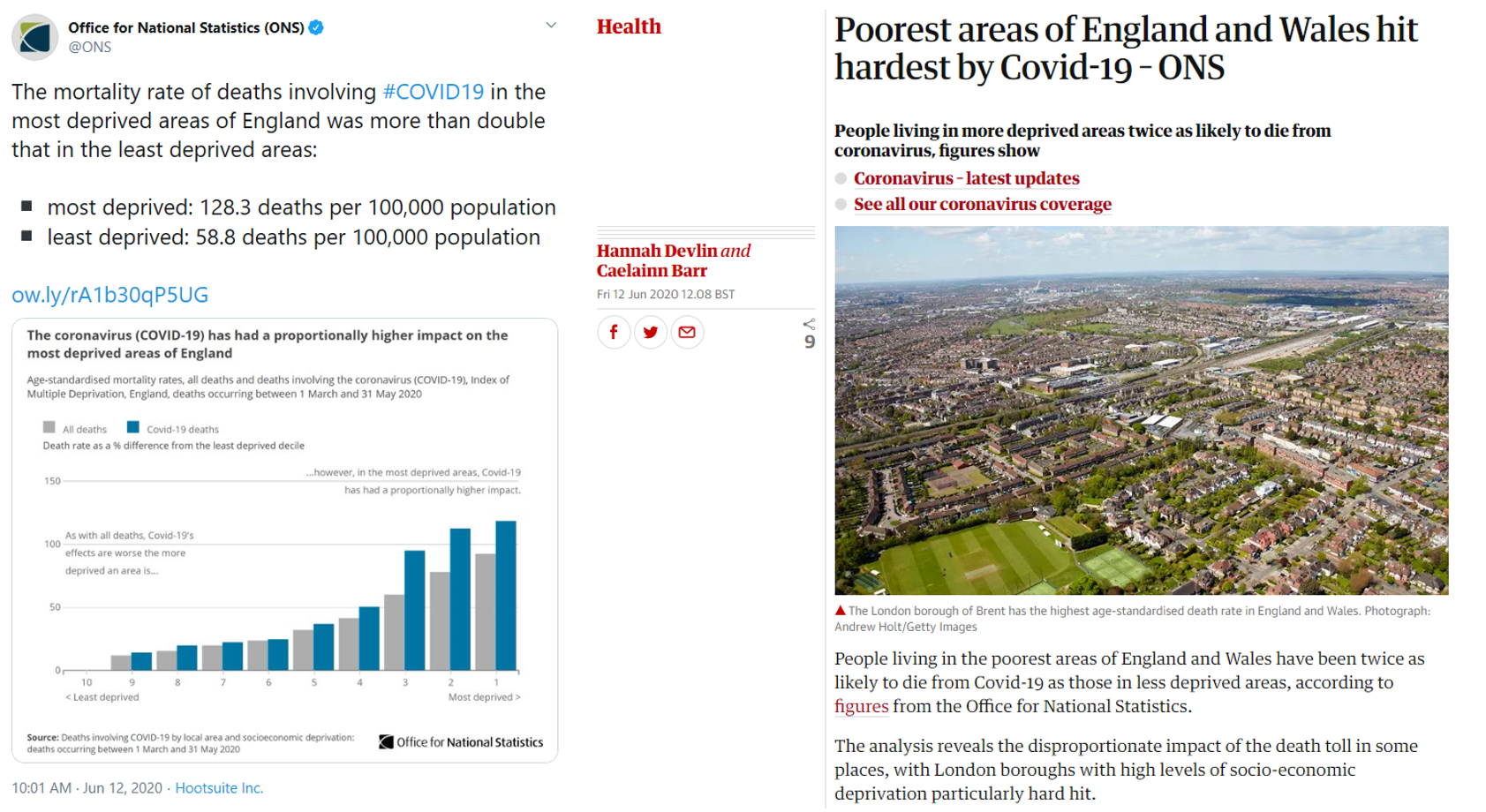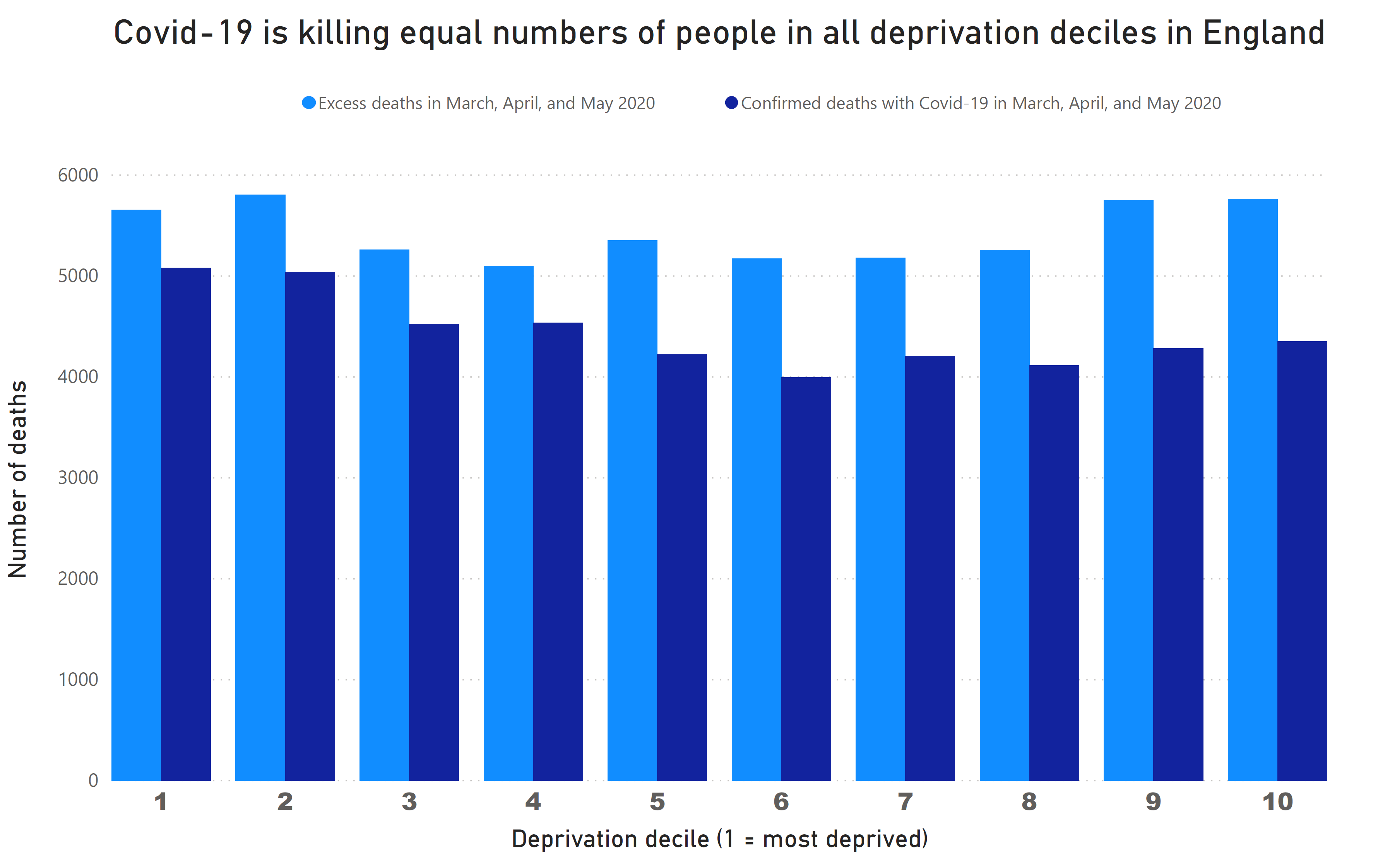
Covid-19 is killing equal numbers of people in all deprivation deciles in England
Is Covid-19 disproportionately killing people living in the most deprived parts of England?
If you saw this tweet from The ONS or read this article in The Guardian I wouldn’t blame you for thinking that the answer is yes.

The answer is no. Covid-19 is killing equal numbers of people in all deprivation deciles in England. I guess that most of the best-informed Britons don’t know. Because their media and their national statistics office has inadvertently misled them with an answer that was close enough to what they wanted to hear that they didn’t take the time to understand it.
Complexity, nuance, and caveats
I first did this analysis at the start of May. I wrote it up with complexity, nuance, and caveats about the data analysis and its presentation included. Two thousand five hundred words of complexity, nuance, and caveats . And, of course, very few people read it. I don’t blame them. Complexity, nuance, and caveats are boring and usually unnecessary. So here’s something much simpler. It took longer to write since writing simply is harder.
The number of people who have died from Covid-19, as measured by the excess deaths method almost everyone agrees is the best way to measure deaths from Covid-19, is equal across all deprivation deciles in England. People in rich places are dying. People in poor places are dying. People in places of every type in between are dying. The same numbers are dying in places in every decile of deprivation, each of which has an equal population.
The data analysis is all open. Check it. Tell me I’m wrong if I’m wrong.

So when The Guardian says “people living in more deprived areas twice as likely to die from coronavirus, figures show” it is wrong.
When The ONS say “the mortality rate of deaths involving Covid-19 in the most deprived areas of England was more than double that in the least deprived areas” that is, I think, wrong.
The second one is less clear cut, because the ONS are meticulous in caveating that claim by stating that “the mortality rate” refers to the age-standardised mortality rate.
But look at The Guardian article. Look at The Scottish Sun’s equivalent, look at the quick interpretation by Max Nathan at LSE, look at The Nuffield Trust’s blog headline, look at ITV’s reporting, The Telegraph, The Telegraph again, The New Statesman, The BBC, I could go on for a full page just of links. Almost everyone is interpreting the data and summarising it (that’s what headlines are) incorrectly. Almost no-one is getting it right. On the ONS tweet I don't think that “deaths per 100,000 population” is the correct unit, even though I know what they’re trying to communicate.
What a disaster!
Age-standardised mortality rate
The problem is age-standardised mortality rate. ASMR means that if you die aged 53 that counts more than if you die aged 84. And that makes a lot of sense when we’re talking about something like strokes. It counts as more of a tragedy if your Mum dies aged 53 from a stroke than if your Grandma dies aged 84 from a stroke. We have big ASMR tables that assign the values for a death at each age. In Europe we use a European standard table called The European Standard Population (ESP).
There are two big discussions to have about ASMR.
The first is, should we be age-standardising Covid-19 deaths using the ESP? That’s the kind of fight that epidemiologists have all the time. I know because I used to work with a lot of them.
My opinion is that it’s too early to do so now. We don’t know infection rates by age very well and thus we don’t know death rates per infection by age very well. It might never be appropriate to age-standardise Covid-19 deaths using the ESP for the same reason as we would never age-standardise deaths from diseases such as measles with an age-profile of mortality different to death by natural causes.
The second discussion is the more important. If almost everyone is misinterpreting reported “death rates” (which are actually age-standardised mortality rates) should you change how you publish and share them?
How to fix it!
We have excellent data. There’s a simple way to fix the misunderstanding. Stop promoting the age-standardised mortality rate first. Start promoting the raw mortality rate. Because that’s what almost everyone is interpreting the data as. Make the data fit their interpretation.
The bigger discussion
There’s a bigger and more difficult discussion to have. It’s about something that I see more and more.
Lots of people really wanted to have a social justice angle on this story. I understand that. And there is one here. But it's probably not the one that most people think.
More and more I see people over-reaching to find those angles in data. The data is a dangerous place to look if you've already decided what you want to find.